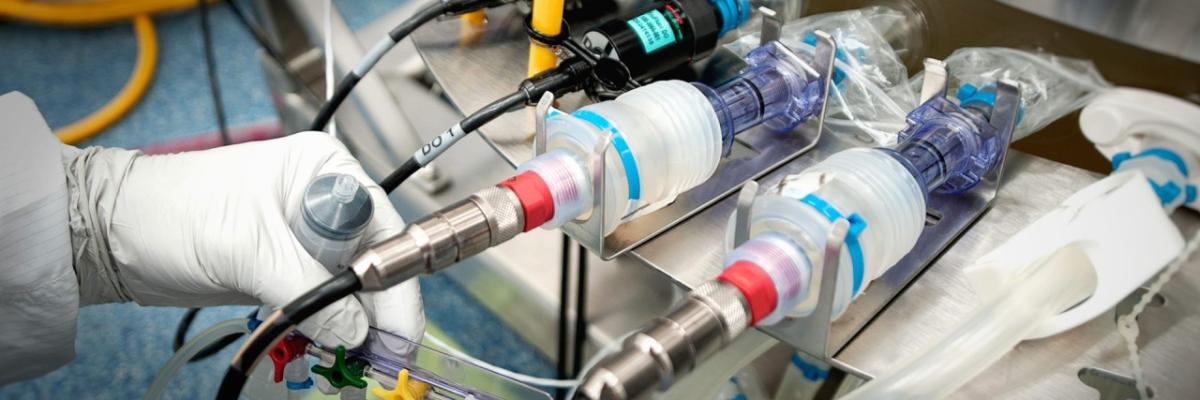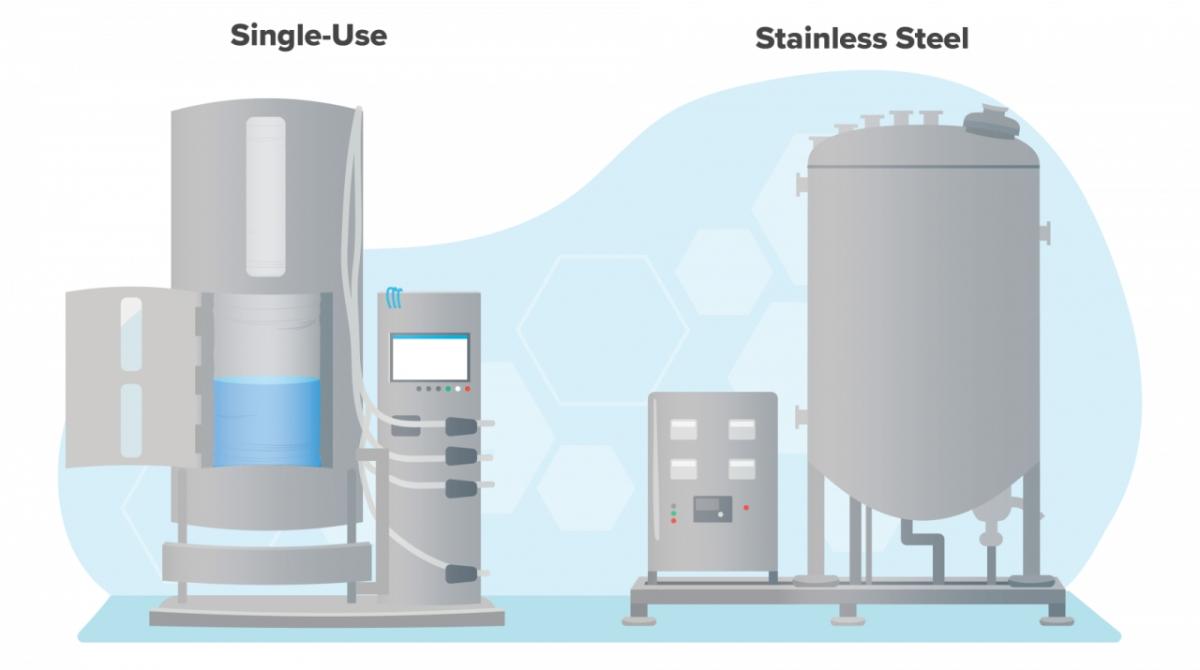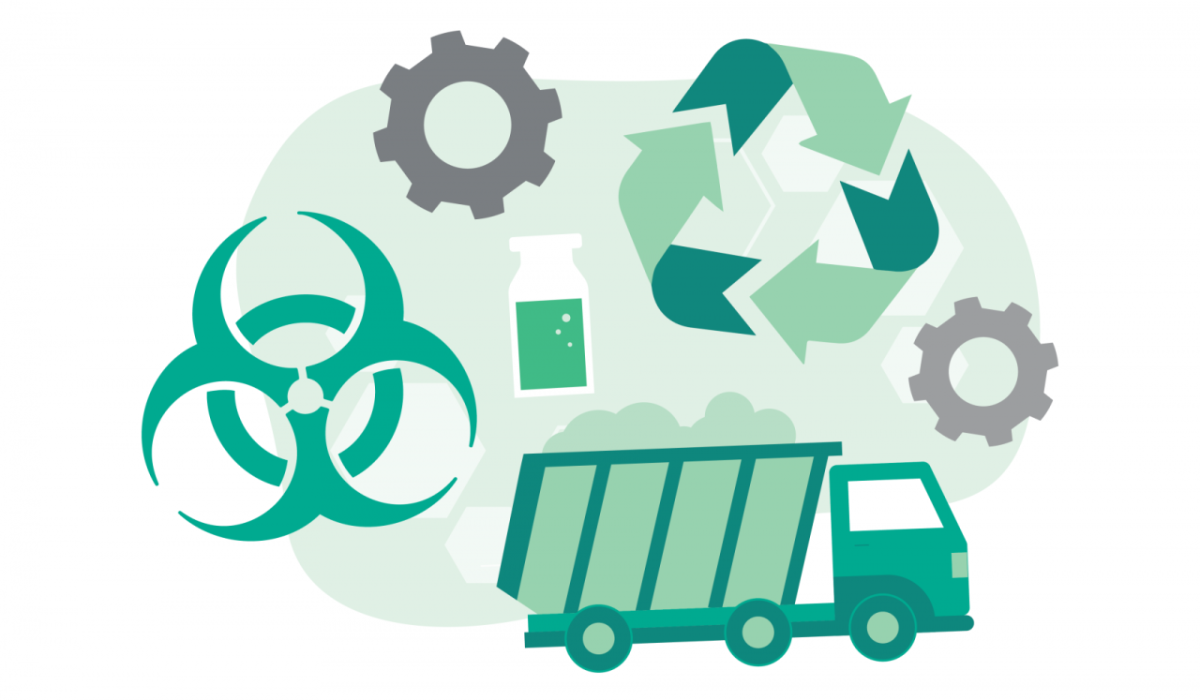Which Is More Sustainable: Stainless Steel or Single-Use Systems?
What are the environmental impacts of single-use technology and stainless steel systems? And which should you use in your next facility?
By Zach Page-Belknap, Energy and Sustainability Specialist
Regardless of the end product or the manufacturing modality, biopharmaceutical processes are resource intensive. The industry is currently taking a hard look at its environmental impact and we’re seeing widespread support in biotech and pharma for sustainable development goals. As we found in our Horizons: The Life Sciences report, 84% of those surveyed have formalized sustainability metrics to measure their progress.
This raises an important question for pharmaceutical manufacturers: between conventional stainless steel and single-use systems, which type of processing equipment will align best with your corporate sustainability goals? The answer largely depends on how your company defines sustainability and what your goals entail, but this article will help you understand the various consumption and waste implications of both.
A comparison of the benefits and downsides of single-use systems vs. stainless steel systems:
Batch volume
Whether a manufacturer selects single-use biopharma equipment or conventional stainless steel may depend on the type of drug and quantity produced. For example, producing the hundreds of kilograms needed for a blockbuster monoclonal antibody (mAb), may require fermentation in 20,000-L stainless steel (SS) bioreactors. This maximizes economy of scale when compared to smaller-volume processes. Meanwhile, single-use systems (SUS) have gathered momentum in biopharma over the past two decades because of their potential with closed system design due to the lack of permanent infrastructure. This ability increases processing flexibility and shrinks the facility footprint. Additionally, single-use systems can produce the smallest batches of drug product needed for personalized medicine and novel modalities, such as mRNA vaccines and cell and gene therapies. These can be made in smaller vessels that rely on single-use bags, tubes, and components, with volumes ranging from less than 1 L volumes for cell and gene therapies to 6,000 L for microbial and mAB products.
Benefits of single-use systems
- Flexibility: Single-use technology has the edge here for producing ATMPs and for those manufacturers needing a high degree of flexibility, such as CDMOs and CMOs.
- The need for CIP/SIP sanitization: Stainless steel and permanent product-contact surfaces require clean-in-place (CIP) and, often, sterilization-in-place (SIP), as per ASME/BPE guidance. CIP/SIP cycles consume considerable time in a production schedule, purified water, and energy to maintain optimal temperatures. Replacing single-use materials is generally quick and doesn’t require purified water or electrical/thermal energy during changeout.
- Process closure: The energy to maintain cleanroom environmental air quality, temperature, and humidity can be a large, if not the largest, energy consumer in a life sciences manufacturing facility. Single-use systems offer the ability to more quickly and easily incorporate new technologies and components to further or completely close a process, creating an opportunity to reduce the cleanroom classification and reduce the cleaning needs of a cleanroom upon proper validation in a shorter timeframe.
- Equipment Density: Single-use systems have the advantage with facility space constraints (i.e. more equipment per unit area). A prime example includes banks of buffer hold bags that can be closely aggregated with daisy-chained jacket-coolant supply or small volume processes for ATMP products that can be localized on a benchtop only requiring gas utility supplies. When combined with space-saving from the lack of CIP/SIP equipment mentioned above, single-use facilities can achieve footprints that are half the size of stainless steel facilities.
Benefits of stainless steel systems
- Scale up: Stainless steel currently has distinct advantages around scalability of single volumes, since vessels can be larger than 20,000 L. Each year equipment manufacturers push the limit of single-use bioreactors, which is currently up to 6,000 L.
- Supply chain vulnerability: Unlike stainless steel, single-use systems require a steady stream of consumables, such as tubing and bags. COVID-19 further increased the risk of supply chain shortages, affecting both new stainless steel and single-use system materials.
- Material testing and validation: Stainless steel and other metals (e.g., AL-6XN®) have mature industry standard practices (e.g., passivation) and strict material limits to minimize leachable and extractable potential. There is far less data on interactions between specific drug product types (e.g., mAb or microbial), supplementary solutions (e.g., media and buffer), and proprietary single-use materials, especially as new polymer compositions are introduced to the market, posing a greater risk with leachables and extractables.
Comparing the operational sustainability of single-use systems and stainless steel processes
There are three primary factors to consider when comparing the operational sustainability—before, during, and after manufacturing—of single-use systems vs. stainless steel equipment:
- Water use
- Energy consumption
- Waste generation and disposal
According to those surveyed for the 2021 Horizons: The Life Sciences report, water and waste are currently the most important sustainability factors in the life sciences industry. Water reuse and reclamation were also flagged in the report as the top means of reducing environmental impacts.
Contrary to our survey’s findings, a comprehensive study of energy use in the pharmaceutical industry (see Table 3 in link) by ENERGY STAR® and Berkeley National Laboratory found that HVAC needs represent the largest energy consumer for nearly every type of space. A potential explanation for these conflicting results is that, in life sciences, lab and cleanroom HVAC requirements—typically the heaviest users within a building—can be viewed as more rigid following validation. Re-validation of these spaces can be much more intensive to justify a lower classification and, therefore less energy consumption, versus simply looking for ways to reduce water use or generated waste, despite HVAC reductions objectively offering greater potential energy savings.
Resource considerations before the manufacturing stage
The environmental impacts of pharma and biotech manufacturing begin well before you produce a drug. To get the full account of sustainability, you must look earlier in the process: when equipment is fabricated, facilities are constructed, and raw materials are transported throughout the supply chain. Here is a look at our three main factors, water, energy, and waste prior to drug production:
Water use
The pharmaceutical industry is considered water-intensive, with the majority of water consumed during manufacturing and in cleaning, in the case of stainless steel. However, a portion of the overall water consumption occurs during stainless steel and single-use technology equipment manufacturing. The production of permanent stainless steel equipment and the raw materials required for fabrication use relatively little water because they occur once. The continuous need for single-use equipment and components requires the ongoing use of water to manufacture polymers (e.g., 60 L water/kg for a common single-use material like virgin polypropylene). Based on the type of polymer and the production method, a year’s worth of single-use system batch supply can easily eclipse the amount needed for stainless steel equipment fabrication.
Energy consumption
A study comparing energy use over the lifetime of using either stainless steel or single-use equipment found that, for material derivation alone, single-use systems consume four times more energy without the inclusion of transportation and delivery of materials. Furthermore, supply chain delivery is a significant source of fossil fuel consumption, especially for the greater volume of consumables needed for single-use processing. In contrast, given that single-use systems typically have smaller infrastructure requirements, cleanroom modularization is possible when designing new facilities, using a multimodal manufacturing system like SlateXpace™, which may achieve significant footprint savings. A smaller building footprint has finite energy savings during construction, but has operational savings over the facility lifetime (in greater detail below), enough to rival the added energy cost of single-use systems derivation and delivery.
Waste Generation
Limited data exists on the waste generated during the creation of stainless steel and single-use system products, given the variety of suppliers and manufacturing processes. However, the waste generated by single-use system material shipment packaging, though often recyclable, can be significant. Suppliers are being pushed to re-evaluate packaging materials to maximize recyclable content and minimize thin film soft plastics, but progress is slow and hindered by access to appropriate recycling facilities. Consumables in stainless steel biopharma facilities also create shipping waste, but this is typically far less.
Resource demands during biopharma manufacturing
Drug production—regardless of whether you use single-use systems or stainless steel equipment—amplifies water and energy demand and accelerates waste creation. But the ways in which each option uses resources and produces waste are different.
Water use
While both types of equipment require purified water for batching buffers and media, single-use technologies can reduce water use by as much as 85% compared to a stainless steel plant, primarily because disposables don’t need CIP/SIP treatment. Cleaning stainless steel manufacturing equipment is the most significant use of water in many pharmaceutical facilities, accounting for 50–70% of all water use. Additionally, disposal of the liquid waste from CIP processes adds to the environmental cost. This process involves waste neutralization equipment, which is an energy consumer that also requires periodic delivery of bulk caustic and acidic chemicals, further increasing pre-manufacturing emissions for those deliveries. On the other hand, spent single-use systems are typically solid waste, as detailed in the waste section below.
Energy consumption
The two primary categories of energy use in life sciences manufacturing are the energy required to cultivate consumable utilities (e.g., purified water and clean steam) and the generation of utilities needed to support manufacturing and building operations (e.g., plant steam, heating hot water, chilled water/glycol). The distinction between these two can be significant, as single-use system facilities rely almost entirely on the latter category for environmental management compared to stainless steel system facilities that may also require considerable consumable utility supply.
When comparing fully stainless steel or single-use system equipment trains over a facility lifetime, one study found that more than 98% of the total energy used for distillation of purified water and to generate clean steam for CIP and SIP could be avoided by using single-use technology processing equipment. The remaining ~2% requirement represents the gamma irradiation needed to sterilize the single-use system materials before use. Eliminating the need for purified water and steam with single-use systems significantly reduces the required capacity of purified water generation assets on-site.
Both stainless steel and single-use systems commonly have manufacturing components that require a parts washer or autoclave. There are now parts washers and autoclaves with built-in heating elements for hot water or steam production, eliminating the need for central steam generation. Single-use system manufacturing can eliminate the need for central steam for these units, but steam may still be needed for material waste disposal, depending on the method chosen.
Stainless steel and single-use system manufacturing equipment use plant steam or chilled water/glycol for temperature control of vessel jackets.
Consider a ‘reduce before you produce’ approach. In some energy-intensive processes, building electrification and renewable energy supply can be the best means to reduce a facility’s carbon footprint and increase resiliency to adverse events, such as grid outages. Many alternative technologies, such as photovoltaics, wind turbines, heat pumps, and battery energy storage systems have reached commercial viability and cost competitiveness with conventional technologies. Their performance and effectiveness are only accentuated by the conservation strategies like process closure.
Elimination of cleanrooms through closed processing is your greatest opportunity to reduce facility energy needs
A life cycle assessment (LCA) of a 2,000-L single-use technology biologics manufacturing facility found that electricity to power cleanroom utilities was the main source of environmental impact. The best way to reduce this impact is to close the manufacturing process so the cleanroom background can be reduced with proper and effective closure.
The reduction or removal of the need for cleanroom air quality control has a ripple effect:
- It decreases the overall square footage of a building in design (e.g., by removal of airlocks), further reducing energy requirements for space conditioning and minimizing utility generation equipment capacity.
- The plant needs fewer and smaller air-handling units and HEPA filters to meet classification minimum specifications. Less conditioned air volume translates directly to energy savings within the air-handling equipment (e.g., fan energy) and with heating and cooling utility supply.
- From a capital perspective, without stringent requirements for cleanroom air qualification, monitoring, and testing, the material costs approach those of a lab or warehouse space.
It’s important to clarify that rigorous testing and validation are required to prove process closure, and that closure can be replicated successfully batch after batch. As demonstrated by numerous facilities over the last decade, both stainless steel and single-use system processes have the potential to be closed. However, the impermanent nature of single-use technology provides a greater opportunity to implement new technologies to allow full closure with minimal or negligible changes to existing infrastructure.
Waste
Conventional stainless steel processing equipment does consume some polymeric components that have to be regularly changed out—notably diaphragms, filter cartridges, and gaskets. However, single-use processing continuously generates larger volumes of disposables, from bioreactor bags to transfer tubing. Single-use manufacturers continue to innovate and are now creating single-use centrifuges and fill and finish skids, further adding to waste streams. For perspective, though the range depends on factors like batch cadence and processing volume.
During the manufacturing process of pharma and biotech products, single-use system facilities can be much more sustainable for water use and on-site energy consumption. However, single-use equipment generates much more solid waste than a stainless steel system.
Post-manufacturing waste management for biopharma
Both processes generate waste. While conventional stainless steel processing predominately generates liquid waste, entire single-use systems can be disposable, and the options for dealing with this volume of solid waste are limited. The large quantities of waste may hamper a company’s ability to marry its current manufacturing equipment and methods with its aggressive sustainability goals.
Water use
A common on-site end-of-use treatment for biohazardous disposable plastics is shredding and steam sterilization. Steam sterilization, usually by autoclaving within the shredding chamber, renders any held-up biohazardous material safe for disposal or handling by sorters. While this significantly reduces the volume of waste from single-use systems, it requires continual water use, reducing any savings accrued from the lack of CIP/SIP. Steam sterilization also nullifies the opportunity to remove clean steam generation from manufacturing facilities and may actually increase the required capacity of central plant boilers if steam is used elsewhere. This is not a factor when waste is incinerated or gasified.
Energy consumption
When using shred and steam processing to sterilize and reduce single-use technology waste volume, the overall facility energy savings are diminished by the energy consumption of the shredding equipment and the energy needed to generate steam. Shred and steaming is an attractive option for most single-use system facilities, given the alternative is expensive biohazardous collection services, which can add up for large volumes. In contrast, on-site shred and steam render the plastics equivalent to municipal waste and can be disposed with common garbage.
Waste disposal
How to sustainably dispose of biopharma plastic waste is complex due to the wide range of polymers that make up plastic components, the potential presence of biological and chemical hazards that need to be inactivated or removed prior to disposal, the cost of various methods, and the geographical availability of facilities capable of alternative methods of disposal. Here are the standard and innovative options to deal with pharmaceutical single-use waste:
Sterilization and disposal at the landfill
While the cheapest and most widely available option is to send waste to a landfill, it comes with high environmental costs. In addition, steam sterilization often adversely affects plastic, making it more difficult to be recycled. For difficult-to-neutralize hazards that cannot be managed by shred and steam, there are alternative solutions such as chemical treatment or gamma irradiation, although these may come with higher capital and operational costs and/or a lack of commercial maturity.
Reuse, recycle, or repurpose
In some cases, disposable components of single-use technology can be reused for test runs and in research and development.
Some, such as tube sets or filters that are not contaminated with hazardous biological or chemical material, can also be recycled. For example, Millipore Sigma’s Biopharma Recycling Program reconstitutes single-use products, such as used liquid or gas filters, which they recycle into industrial-grade plastic lumber. Unfortunately, multiple equipment manufacturers often make similar products, each with a novel and proprietary blend of plastics, making it difficult to have a universal recycling stream for all components. Another limitation is that some plastics contain non-recyclable silicone, such as thermosets. For this and similar situations, evaluate single-use technology suppliers for alternative materials to ensure recyclability. If none currently exist, manufacturers who offer routes for waste diversion may be willing to develop new materials to fit end-user processes.
Plastics that have been heat treated are often unable to be recycled into starting material with properties similar to virgin plastics. In this case, components can be repurposed into non-structural building materials or park benches.
Incineration
Single-use plastic waste incineration offers a low-cost disposal option that is safe for hazardous materials. It also has the potential benefit of power production and thermal energy recovery via cogeneration. However, incineration incurs significant capital costs and generates greenhouse gas emissions (e.g., particulates and gasses).
Pyrolysis
Pyrolysis is a high-heat process that breaks down plastics with temperatures of approximately 4,000o C in the absence of oxygen. While upfront costs can be high, the sustainability benefits are potentially substantial, with one kilogram of plastic converting to approximately one liter of fuel similar to diesel. Commercially viable pyrolysis processes are still in development and require large volumes of plastics to be feasible at the current technological scale.
Steam gasification
Steam gasification is an emerging technology that decomposes plastic into syngas—primarily carbon monoxide and hydrogen—in the presence of high heat, pressure, and steam. Syngas can then be reconstituted into a range of end products and used to generate electricity. The process also generates recoverable heat through the HVAC system at the disposal facility. Of all the alternative disposal options for single-use technology, steam gasification may offer the best route to minimize carbon emissions (depending on the syngas end use) while providing site resiliency in the form of electrical and thermal energy. This type of innovative energy recovery is on the verge of commercial adoption. One such technology, FastOx® Gasification, is being developed by Sierra Energy.
Life cycle assessments of stainless steel and single-use technologies
When discussing solid waste generation, the focus is typically on the steady creation of plastic waste from single-use systems, but what happens to all the equipment in a stainless steel facility is often an afterthought. It is worth considering, however, that potentially an entire production train’s worth of stainless steel must be disposed of at the end of the facility’s lifespan—approximately 20 years. Some equipment may be resold, but typically it’s all scrapped and melted down for reuse, which is another energy-intensive process.
Evaluating the total environmental impact includes a measurement of embodied carbon, an estimate of greenhouse gas emissions resulting from manufacturing, transportation, installation, maintenance, and disposal of manufacturing equipment and related materials. This is the holistic, end-to-end cost of a piece of equipment often referred to as “cradle to grave.”
A life cycle assessment (LCA) allows a comparison of the environmental impacts of different equipment over a fixed time frame. It quantifies the environmental costs of water use, waste generation, and energy consumption to construct, transport, and dispose of equipment.
For example, an LCA comparing the environmental impacts—on ecosystems, human health, and resources—of manufacturing mAbs with either single-use or a stainless steel process train found that single-use processing had less impact. However, the study only considered ten batches worth of single-use processing trains; stainless steel equipment is capable of ten or more years of service in its lifetime, which commonly exceeds ten total batches by a considerable amount. Thus, while single-use technology may offer less impact when looking at a finite portion of a facility’s lifetime, stainless steel processes win in the long run if they are maintained for longer than ten batch cycles in similar cases.
Integrate your sustainability goals early in the design phase
There is no absolute winner when evaluating stainless steel and single-use technology as they each have advantages and disadvantages given your particular process or facility location. When comparing the sustainability of stainless steel and single-use equipment for pharma manufacturing, it’s important to perform a comprehensive evaluation, which is most effective at the design’s onset. You may see missed opportunities when the sustainability conversation happens later in a project’s development.
At CRB, we strive to collaborate and integrate our clients’ sustainability goals starting from the design phase of new projects, as we demonstrated with this fully-electric CAR T therapy biotech facility. We encourage our clients to engage in a sustainability charrette as a first step, setting goals for natural resources and waste management, to see benefits like improved product flexibility, facility resiliency, and a decrease in operating expenses.
Dovetailing sustainability goals with the realities of pharmaceutical manufacturing is a daunting task. Despite technological, economic, and mindset challenges, great strides have been made in recent years to reduce the environmental impact of manufacturing life-saving medicines.
Whether your goal is reducing your Scope 1 emissions or going carbon neutral, our engineers are ready to design your next sustainable facility. Talk to our sustainability engineers.







